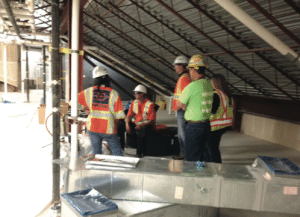Naval Base Turns To Aeroseal To Solve Mold & Mildew Issues

The renovation experts at Washington Patriot Construction (WPC) couldn’t say for sure that poor ventilation was causing persistent mold and mildew problems for one of the bachelor enlisted quarters at the Kitsap Naval Base in Washington State, but it was certainly a major suspect. The exhaust fan serving the four-story 380+ room building was working 24/7 and was supposed to pull 60 CFM out of each of the bathrooms and shower areas. Testing of the individual ventilation ducts revealed, however, that they were drawing just 25 to 30 CFM at best – in some cases, none at all.
“One of our first strategies for increasing ventilation was to move some of the ductwork closer to the shower area where a lot of the moisture issues were coming from,” said Mark Zygmontowicz, senior project manager for Washington Patriot Construction. “We retested after the move and while that helped a little, it still did not provide the 60 CFM we needed.”
So they then turned their attention to the 24 ventilation shafts running vertically through the four-story structure. Each shaft contained a supply and return duct that serviced four rooms on each floor. When WPC tore into the walls of the shafts, another problem became obvious.
“As soon as we pulled air out of the exposed ducts, we could actually hear air whistling out,” said Zygmontowicz, “a clear indication that there was some amount of leakage in the ductwork.”
To fix the leaks, WPC did a trial test of manually sealing a portion of the exposed ductwork that could be reasonably accessed from the outside. Retesting showed that while this helped increase ventilation airflow to some degree, it once again was not sufficient to meet system requirements or to pass inspection. And even if it did, the prospect of manually sealing all 48 ducts was daunting. It would have required major wall demolition with results that, due to the size of the project and the inaccessibility of much of the ductwork, would have been iffy at best.
As the crew puzzled over their next steps, one of the engineers on the project mentioned that he had heard about a duct sealing technology called Aeroseal that worked from the inside of the ductwork to seal leaks. This inside-out approach meant that accessing the ductwork wouldn’t be an issue. It wouldn’t require tearing into walls and identifying and sealing the individual leaks became an automatic process rather than a manual task.
The Navy’s initial reaction to the proposed use of Aeroseal duct sealing was skepticism. They weren’t familiar with the technology and not happy about the added cost.
“We then learned that Aeroseal was actually used to solve HVAC issues in another building on the same navy base, just a year or so ago,” said Zygmontowicz. “And we found that Aerosealing the shafts penciled out to be the least expensive option on the table. This gave the Navy the confidence they needed to approve the project and move forward.”
Aerosealing the ductwork was a relatively simple process. All of the ducts could be sealed through openings readily accessible from their end points in the attic. Registers for each vent were temporarily blocked so that the only escape route for air inside the ductwork was out through the leaks. Sealant was then blown into the interior of each duct.
It took a little over three weeks to seal all 48 ducts. At the conclusion of each duct sealing, the Aeroseal system measured leakage and generated a report. The final summary highlighted the success of the project: before sealing began, the entire system was losing 7,289 CFM of air. After sealing, total leakage measured just 170 CFM.
“Aeroseal reduced leakage by about 97% and got overall leakage down to around 3% to 7% – well within specifications,” said Zygmontowicz.
Now, with the duct system leak free, all of the living quarters, bathrooms and shower areas easily get the 60 CFM of ventilated air they were designed to receive – even with the exhaust fan set significantly lower. Proper ventilation solved the mold and mildew issues and the reduced fan power had a significant impact on reducing energy costs.
“The proof is in the results,” said Zygmontowicz. “Aeroseal makes sense for any building renovation in which you have issues with mold or mildew or simply need to get moisture out of the building. Leaks in the ductwork were the cause of the problem and Aerosealing those leaks was really the only viable solution.”

